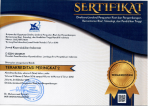Pengaruh karakteristik ibu terhadap munculnya pekerja anak di Indonesia tahun 2018
Abstract
The issue of child labor remains unresolved in Indonesia, hindering the achievement of one of the United Nations' Sustainable Development Goals (SDGs), which is to end child labor in all forms by 2025. This study aimed to examine the characteristics of child laborers aged 10-17 years old and the impact of maternal characteristics on child labor in Indonesia in 2018. The study analyzed data from the 2018 Indonesian Central Bureau of Statistics (Susenas KOR) survey using binary logistic regression. The results showed that most child laborers had mothers who were heads of households, had low levels of education, were disabled, had severe illnesses, were of productive age, had previously been married, and were recent migrants. It was concluded that maternal position in the household, maternal education level, maternal health status for severe illnesses, maternal age, and migration status significantly affected the prevalence of child labor in Indonesia in 2018. On the other hand, maternal physical condition, health status for mild illnesses, and marital status did not have an impact on child labor in Indonesia in 2018.
Keywords
Full Text:
PDFReferences
Abdallah, A.S.R. (2020). Using logistic regression to identify the factors affecting child labor in Red Sea State. International Journal of Advanced and Applied Sciences, 7(10), 12-19. https://doi.org/10.21833/ijaas.2020.10.002
Akarro, R.R.J., & Mtweve, N. A. (2011). Poverty and its association with child labor in Njombe district in Tanzania: The case of Igima Ward. Current Research Journal of Social Sciences, 3(3): 199-206. https://maxwellsci.com/print/crjss/v3-188-198.pdf
Al Zayadi, H.A.N., & Al Zayadi, H.S.H. (2018). A geographical analysis of the phenomenon of child labor in the city of Nasiriya. Study in social geography. Alustath Journal for Human and Social Science, 226 (2), 435-454. https://doi.org/10.36473/ujhss.v226i2.70.
Amir, F., Ashar, K & Pratomo, D.S. (2019). Pengaruh budaya & bargaining power terhadap partisipasi kerja dan sekolah anak di Jawa Timur. Jurnal Ekonomi Kuantitatif Terapan, 12 (1), 1-9. https://doi.org/10.24843/JEKT.2019.v12.i01.p01
Anderson, S., & Eswaran, M. (2009). What determines female autonomy? Evidence from Bangladesh. Journal of Development Economics, 90(2), 179-191. https://doi.org/10.1016/j.jdeveco.2008.10.004
Ariyanti, I. (2016). Socio economc factors affecting the child labour in Palembang city Indonesia. Journal of Internet Banking and Commerce, 21(2), https://www.icommercecentral.com/open-access/socio-economic-factors-affecting-the-child-labour-in-palembang-city-indonesia.php?aid=78453
Basu, K. (2011). Gender and say: A model of household behavior with endogenously-determined balance of power. The Economic Journal, 116(511), 558-580. https://doi.org/10.1111/j.1468-0297.2006.01092.x
Basu, K., & Ray, R. (2002). The collective model of the household and an unexpected implication for child labor: Hypothesis and an empirical test. Policy Research Working Paper 2813. http://documents.worldbank.org/curated/en/433691468757838910/The-collective-model-of-the-household-and-an-unexpected-implication-for-child-labor-hypothesis-and-an-empirical-test
Behera, P. K. & Das, S. (2016). Factors Responsible For the Incidence of Child Labour: A Study in Cuttack City, Odisha. IOSR-JEF, 7 (4), 24-32. https://doi.org/10.9790/5933-0704022432
Behrman, J. R. (1997). Intrahousehold distribution and the family. dalam M.R Rosenzweig & O. Stark (Eds.), Handbook of family and population economics (Vol 1A., pp. 125-187). Elsevier Science B.V. https://doi.org/10.1016/S1574-003X(97)80021-9
BPS. (2018, 16 Juli). Berita Resmi Statistik No. 57/07/ThXXI. Badan Pusat Statistik. https://www.bps.go.id/pressrelease/2018/07/16/1483/persentase-penduduk-miskin-maret-2018-turun-menjadi-9-82-persen.html
Bratti, M., & Mendola, M. (2014). Parental health and child schooling. Journal of Health Economics, 35, 94–108. https://doi.org/10.1016/j.jhealeco.2014.02.006
Brown, D. K., Deardorff, A. V & Stern, R. M. (2002). The determinants of child labor: Theory and evidence. Discussion paper 486. https://fordschool.umich.edu/rsie/workingpapers/Papers476-500/r486.pdf
Darmika, W. D. B. & Usman, H. (2020). Pengaruh karakteristik kepala rumah tangga dan rumah tangga terhadap munculnya pekerja anak di Indonesia tahun 2018: Analisis data Susenas 2018. Prosiding Seminar Nasional Official Statistics 2020, 1, 462-471 https://doi.org/10.34123/semnasoffstat.v2020i1.399
Darusasi, R. & Pitoyo, A. J. (2013). Kondisi demografi dan sosial ekonomi rumah tangga pekerja anak DKI Jakarta (analisis data susenas kor 2010). Jurnal Bumi Indonesia, 2(1), 69 – 76.
de Mesquita, S. P., & de Farias Souza, W. P. S. (2018). Child labor and family structure: The role of divorce. International Journal of Social Economics, 45(10), 1453–1468. https://doi.org/10.1108/IJSE-07-2017-0287.
Doss, C. (2011). Intrahousehold bargaining and resource allocation in developing countries. https://openknowledge.worldbank.org/handle/10986/19492
Elwan, L. O. M. & Aslim, L. O. (2019). Permasalahan Pekerja Anak di Kota Kendari. Journal of Public Administration and Government, 1(1), 36-45. https://doi.org/10.22487/jpag.v1i1.14
Endrawati, N. (2012). Perlindungan hukum terhadap pekerja anak di sektor informal (Studi kasus di Kota Kediri). Jurnal Dinamika Hukum, 12(2), 270–283. http://dx.doi.org/10.20884/1.jdh.2012.12.2.47
Fernandez, R.C.E., & Abocejo, F. T. (2014). Child labor, poverty and school attendance: Evidences from the Philippines by region. CNU-JHE, 8, 114–127. https://www.researchgate.net/publication/319505916_Child_Labor_Poverty_and_School_Attendance_Evidences_from_the_Philippines_by_Region
Genicot, G., Mayda, A. M., & Mendola, M. (2016). The Impact of Migration on Child Labor : Theory and Evidence From Brazil (Discussion Paper Series 10444). https://docs.iza.org/dp10444.pdf
ILO. (1973). C138 - Minimum age convention. International Labour Organization. https://www.ilo.org/dyn/normlex/en/f?p=NORMLEXPUB:12100:0::NO::P12100_ilo_code:C138#:~:text=The%20minimum%20age%20for%20admission%20to%20any%20type%20of%20employment,2.
ILO. (2017). Global estimates of child labour : Result and trends, 2012-2016. International Labour Organization. https://www.ilo.org/wcmsp5/groups/public/---dgreports/---dcomm/documents/publication/wcms_575499.pdf
ILO. (2018). Tujuan pembangunan millenium: Referensi manual serikat pekerja pada agenda untuk pembangunan berkelanjutan 2030. International Labour Organization. https://www.ilo.org/wcmsp5/groups/public/---asia/---ro-bangkok/---ilo-jakarta/documents/publication/wcms_646001.pdf
Iryani, B. S., & Priyarsono, D. S. (2013). Eksploitasi terhadap anak yang bekerja di Indonesia. Jurnal Ekonomi dan Pembangunan Indonesia, 13(2),177–195. https://doi.org/10.21002/jepi.v13i2.226
KemenPPPA & BPS. (2019). Profil Anak Indonesia 2019. Kementerian Pemberdayaan Perempuan dan Perlindungan Anak. https://www.kemenpppa.go.id/lib/uploads/slider/e56dc-15242-profil-anak-indonesia_-2019.pdf
Jafarey, S., & Lahiri, S. (2001). Child labour: Theory, policy and evidence. World economics journal, 2(1), 69–93. https://www.world-economics-journal.com/Journal/Papers/Child%20Labour.details?ID=47
Jussi, I. (2009). Work ability - A comprehensive concept for occupational health research and prevention. Scandinavian Journal of Work, Environment and Health, 35(1), 1–5. https://doi.org/10.5271/sjweh.1304
Kambhampati, U. S. (2009). Child schooling and work decisions in India: The role of household and regional gender equity. Feminist Economics, 15 (4), 77-112. https://doi.org/10.1080/13545700903153997
Keputusan Menteri Tenaga Kerja dan Transmigrasi Republik Indonesia No. Kep.235/MEN/2003 tentang jenis-jenis pekerjaan yang membahayakan kesehatan, keselamatan atau moral anak. https://jdih.kemnaker.go.id/asset/data_puu/peraturan_file_213.pdf
Kibe, S. W. (2017). Essays on women’s bargaining power: Evidence from India [Disertasi Doktor, Fordham University]. research library. https://research.library.fordham.edu/dissertations/AAI10277270
Krutikova, S. (2009). Determinants of child labour: The case of Andhra Pradesh. Young Lives Working Paper, 48. https://www.younglives-india.org/sites/default/files/YL-WP48-Krutikova-ChildLabour_0.pdf
Kusumawardhani, N., & Warda, N. (2013). Migrasi orang tua dan kejadian anak yang bekerja : Bukti dari Indonesia rumusan permasalahan [presentasi power point]. Child Poverty and Social Protection Conference, Indonesia. http://cpsp.smeru.or.id/Ppt%20Day%202/Theme3%20Kalasan1/Niken_ppt_bahasa.pdf
Lal, B. S. (2019). Child labour in India: Causes and consequences. International Journal of Science and Research, 8(5), 2199–2206. https://www.ijsr.net/archive/v8i5/ART20198458.pdf
Lee, E.S. (1966). A Theory of Migration. Demography, 13(1), 47-57. https://doi.org/10.2307/2060063
Majlesi, K. (2016). Labor market opportunities and women’s decision making power within households. Journal of Development Economics, 119, 34–47. https://doi.org/10.1016/j.jdeveco.2015.10.002
Mendolia, S., Nguyen, T., & Yerokhin, O. (2017). Impact of parental health on children ’ s schooling and labour force participation : Evidence from Vietnam (Discussion Paper Series 10651). https://docs.iza.org/dp10651.pdf
Mont, D., & Nguyen, C. (2013). Does parental disability matter to child education? Evidence from Vietnam. World Development, 48, 88–107. https://doi.org/10.1016/j.worlddev.2013.04.001.
Morgan, P. J., & Trinh, L. Q. (2018). Heterogeneous Effects of Migration on Child Welfare : Empirical Evidence From Viet Nam (ADBI Working Paper Series 835). https://www.adb.org/sites/default/files/publication/418491/adbi-wp835.pdf
Nandi, N. (2016). Pekerja anak dan permasalahannya. Jurnal Geografi Gea, 6(1). https://doi.org/10.17509/gea.v6i1.1731.g1181
Nguyen, T., & Purnamasari, R. S. (2011, Maret). Impacts of international migration and remittances on child outcomes and labor supply in Indonesia : How does gender matter ? (World Bank Policy Research Working Paper) https://doi.org/10.1596/1813-9450-5591
Pitriyan, P. (2006, Agustus). The impact of child labor on child s education : The case of Indonesia. Working paper in economics and development studies, 200609. Center for Economics and Development Studies. http://ceds.feb.unpad.ac.id/wopeds/200609.pdf
Priyambada, A., Suryahadi, A., & Sumarto, S. (2005). What happened to child labor in indonesia during the economic crisis? The trade-off between school and work. SMERU Research Institute, Working Paper (Issue September). https://smeru.or.id/en/publication/what-happened-child-labor-indonesia-during-economic-crisis-trade-between-school-and-work
Purwanti, P. A. P. (2014). Pengaruh karakteristik rumah tangga desa dan kota terhadap alokasi waktu anak untuk bekerja di Indonesia. Jurnal piramida Vol. X No. 2 : 86 – 93. https://openknowledge.worldbank.org/handle/10986/19492
Purwatiningsih, S. (2016). respons anak-anak migran terhadap migrasi internasional di perdesaan ponorogo. Populasi, 24(1), 57–71. respons anak-anak migran terhadap migrasi internasional di perdesaan ponorogo
Quisumbing, A.R., & McClafferty. (2000). Using Gender Research in Development. Food Security in Practice Technical Guide Series No 2. https://doi.org/10.2499/0896297551.ch2
Rad, E. H., Gholampoor, H., & Jaafaripooyan, E. (2015). Child labor and the influencing factors: Evidence from less developed provinces of Iran. Iranian Journal of Public Health, 44(9), 1244–1252. https://ijph.tums.ac.ir/index.php/ijph/article/view/3395/3104
Rosidah, I. (2012). Quo vadis pekerja anak dalam tinjauan hukum. LBH Yogyakarta. https://lbhyogyakarta.org/2012/05/30/quo-vadis-pekerja-anak-dalam-hukum/
Sahu, K. K. (2013). An empirical study of determinants of child labour. International Journal of Science, Environment and Technology, 2(3), 423 – 433. https://www.ijset.net/journal/115.pdf
Sekaringsih, R. B. (2013). Dampak pengambilan keputusan dalam rumah tangga terhadap pendidikan anak dan kesehatan anak. Temuan Sakerti Tahun 2000 dan 2007.
Sugiyani, E. (2000). Perlindungan hak bagi pekerja anak melalui program literacy class di Yayasan Pemerhati Sosial Indonesia [Skripsi, UIN Syarif Hidayatullah Jakarta]. Respositoryuinjkt. http://repository.uinjkt.ac.id/dspace/handle/123456789/7218
Sun, A., & Yao, Y. (2010). Health shocks and children’s school attainments in rural China. Economics of Education Review, 29(3), 375–382. https://doi.org/10.1016/j.econedurev.2009.04.006
Undang-Undang Republik Indonesia Nomor 20 Tahun 1999 Tentang Pengesahan ILO Convention No 138 mengenai Usia Minimum untuk Diperbolehkan Bekerja. Negara Republik Indonesia, 138. https://www.dpr.go.id/dokjdih/document/uu/UU_1999_20.pdf
Undang-Undang Republik Indonesia Nomor 1 Tahun 2000 tentang Pengesahan Konvensi ILO Nomor 182 mengenai Mengenai Pelarangan dan Tindakan Segera Penghapusan Bentuk-Bentuk Pekerjaan Terburuk untuk Anak. https://www.ilo.org/dyn/natlex/docs/ELECTRONIC/56658/105729/F1902768125/IDN56658%20%20IND.pdf
Undang-Undang Republik Indonesia Nomor 23 Tahun 2002 tentang Perlindungan Anak. https://jdihn.go.id/files/4/2002uu023.pdf
Undang-Undang Republik Indonesia Nomor 13 Tahun 2003 tentang Ketenagakerjaan. Sekretariat Negara. Jakarta. https://kemenperin.go.id/kompetensi/UU_13_2003.pdf
United Nations. (1989). Convention on the Rights of the Child. https://www.unicef.org/child-rights-convention/convention-text
Usman, H & Nachrowi, D. N. (2004). Pekerja anak di Indonesia : Kondisi, determinan dan eksploitasi (kajian kuantitatif). Grasindo.
van de Glind, H. (2010, September). Migration and child labour exploring child migrant vulnerabilities and those of children left-behind. Working paper. https://hdl.handle.net/1813/101442
Wagstaff, A. (2005). The economic consequences of health shocks. World Bank Policy Research Working Paper 3644, 202. http://hdl.handle.net/10986/8307
Webbink, E., Smits, J., & de Jong, E. (2013). Household and context determinants of child labor in 221 districts of 18 developing countries. Social Indicators Research, 110(2), 819–836. https://doi.org/10.1007/s11205-011-9960-0
DOI: https://doi.org/10.14203/jki.v17i2.643
Copyright (c) 2022 Jurnal Kependudukan Indonesia

This work is licensed under a Creative Commons Attribution-NonCommercial-ShareAlike 4.0 International License.
-----------------------------------------------------------------------------------------------------------------------------
Research Center for Population, Indonesian Institute of Sciences
Widya Graha Building, 7th and 10th floors
Jl. Jenderal Gatot Subroto 10 Jakarta Selatan, Telp (021) 5221687
Website: http:/kependudukan.lipi.go.id;
E-Journal: http://ejurnal.kependudukan.lipi.go.id
Pustaka: http://pustaka.kependudukan.lipi.go.id
-----------------------------------------------------------------------------------------------------------------------------








